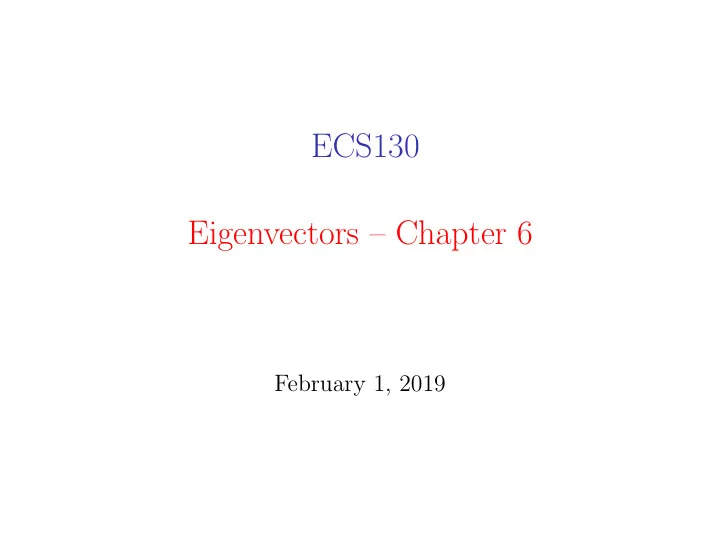

ECS130 Eigenvectors – Chapter 6 February 1, 2019
Eigenvalue problem For a given A ∈ C m × n , find 0 � = x ∈ C n and λ ∈ C , such that Ax = λx. ◮ x is called an eigenvector ◮ λ is called an eigenvalue ◮ ( λ, x ) is called an eigenpair
Motivation Principal Component Analysis (PCA) ˆ v � x i x i − proj ˆ � v � x i { c ˆ v : c ∈ R } (a) Input data (b) Principal axis (c) Projection error � minimize v � x i − proj v x i � 2 i subject to � v � 2 = 1
Motivation Spectral Embedding x 1 x n (a) Database of photos (b) Spectral embedding � w ij ( x i − x j ) 2 minimize x E ( x ) = i,j subject to x T 1 = 0 � x � 2 = 1 , where x = ( x 1 , x 2 , . . . , x n ) T .
Eigenvalues and eigenvectors Let A ∈ C n × n . 1. A scalar λ is an eigenvalue of an n × n A and a nonzero vector x ∈ C n is a corresponding (right) eigenvector if Ax = λx. A nonzero vector y is called a left eigenvector if y H A = λy H . 2. The set λ ( A ) = { all eigenvalues of A } is called the spectrum of A . 3. The characteristic polynomial of A is a polynomial of degree n : p ( λ ) = det( λI − A ) .
Properties The following is a list of properties straightforwardly from above definitions: 1. λ is A ’s eigenvalue ⇔ λI − A is singular ⇔ det( λI − A ) = 0 ⇔ p ( λ ) = 0. 2. There is at least one eigenvector x associated with A ’s eigenvalue λ . 3. Suppose A is real. λ is A ’s eigenvalue ⇔ conjugate ¯ λ is also A ’s eigenvalue. 4. A is singular ⇔ 0 is A ’s eigenvalue. 5. If A is upper (or lower) triangular, then its eigenvalues consist of its diagonal entries.
Schur decomposition Let A be of order n . Then there is an n × n unitary matrix U (i.e., U H U = I ) such that A = UTU H , where T is upper triangular. By the decomposition, we know that the diagonal elements of T are the eigenvalues of A .
Spectral Theorem If A is Hermitian, i.e., A H = A , then by Schur decomposition, we know that there exist an unitary matrix U such that A = U Λ U H , where Λ = diag ( λ 1 , λ 2 , . . . , λ n ) . Furthermore, all eigenvalues λ i are real. Spectral theorem is considered a crowning result of linear algebra.
Simple and defective matrices A ∈ C n × n is simple if it has n linearly independent eigenvectors; otherwise it is defective . Examples. 1. I and any diagonal matrices is simple. e 1 , e 2 , . . . , e n are n linearly independent eigenvectors. � 1 � 2 2. A = is simple. It has two different 4 3 eigenvalues − 1 and 5, it has 2 linearly independent � − 1 � 1 1 � 1 � eigenvectors: √ and √ . 1 2 2 5 3. If A ∈ C n × n has n different eigenvalues, then A is simple. � 2 � 1 4. A = is defective. It has two repeated 0 2 eigenvalues 2, but only one eigenvector e 1 = (1 , 0) T .
Eigenvalue decomposition A ∈ C n × n is simple if and only if there exisits a nonsingular matrix X ∈ C n × n such that A = X Λ X − 1 , where Λ = diag ( λ 1 , λ 2 , . . . , λ n ) . In this case, { λ i } are eigenvalues, and columns of X are eigenvectors, and A is called diagonalizable .
Similarity transformation ◮ n × n matrices A and B are similar if there is an n × n non-singular matrix P such that B = P − 1 AP . ◮ We also say A is similar to B , and likewise B is similar to A ; ◮ P is a similarity transformation . A is unitarily similar to B if P is unitary. ◮ Properties. Suppose that A and B are similar: B = P − 1 AP. 1. A and B have the same eigenvalues. In fact p A ( λ ) ≡ p B ( λ ). 2. Ax = λx ⇒ B ( P − 1 x ) = λ ( P − 1 x ). 3. Bw = λw ⇒ A ( Pw ) = λ ( Pw ).
Recommend
More recommend